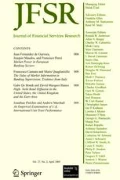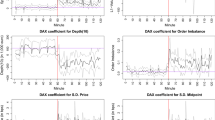Abstract
Foreign exchange-traded funds (ETFs) trade on U.S. exchanges but provide broad exposure to foreign markets. ETFs are designed to minimize the deviation between price and value of the underlying securities. However, nonoverlapping trading hours between the United States and many foreign markets inhibit this mechanism. The data for Japan and Hong Kong iShares show that deviations exist between the ETF price and the value of the underlying securities. The deviations are positively related to subsequent ETF returns creating potential profit opportunities. A simple trading rule based on this observation produces impressive gross returns when compared to a buy-and-hold strategy.
Similar content being viewed by others
References
Barney, L. “Challenges Seen in Exchange Fund Growth.” Mutual Fund Market News 8 (2000), 3–5.
Damato, K., and A. Lucchetti. “Critics Worry about Risks of Exchange-Traded Funds.” The Wall Street Journal (July 7, 2000).
DeBondt, Werner F. M., and R. Thaler. “Further Evidence on Investor Over-reaction and Stock Market Seasonality.” In: R. Thaler, ed., Quasi Rational Economics. The Russell Sage Foundation, 1991.
DeBondt, Werner F.M., and R. Thaler. “Does the Stock Market Overreact?” Journal of Finance 40 (1985), 793–808.
Dellva, W. “Exchange-Traded Funds Not for Everyone.” Journal of Financial Planning 14 (2001), 110–124.
Fama, Eugene F. “Market Efficiency, Long-Term Returns, and Behavioral Finance.” Journal of Financial Economics 49 (1998), 283–306.
Financial Research Corporation. “Exchange-Traded Funds: An Emerging Alternative to Mutual Funds.” Working Paper, Boston, 2000.
Gastineau, G. “Exchange-Traded Funds: An Introduction.” Journal of Portfolio Management 27 (2001), 88–96.
Gastineau, G. The Exchange Traded Funds Manual. New York: John Wiley and Sons, 2002.
iShares Prospectus, Barclays Global Investors. Available at www.ishares.com (January 2002).
iShares Statement of Additional Information. Available at www.ishares.com (January, 2002).
McNally, K., D. Emanuel, and J. Chiu. “FUNDamental Ideas for Exchange-Traded Funds.” Salomon Smith Barney U.S. Equity Research report (October 18, 2000).
Novakoff, J. L. “Exchange Traded Funds: A White Paper.” Levitt Novakoff & Co., LLC. (February 24, 2000).
Regnier, P. “The New Force in Funds.” Money 29 (2000), 126–128.
Salomon, R. S. Jr., and D. H. Tarasow. “The virtues of ETFs.” Forbes 166 (October 2, 2000), 206.
Wiandt, J. “Lee Kranefuss Interview.” Available at www.indexfunds.com (September 25, 2000).
Williams, F. “ETFs: market up 82% to nearly $76 billion.” Pensions and Investments 29 (2001), 25–30.
Author information
Authors and Affiliations
Rights and permissions
About this article
Cite this article
Jares, T.E., Lavin, A.M. Japan and Hong Kong Exchange-Traded Funds (ETFs): Discounts, Returns, and Trading Strategies. Journal of Financial Services Research 25, 57–69 (2004). https://doi.org/10.1023/B:FINA.0000008665.55707.ab
Issue Date:
DOI: https://doi.org/10.1023/B:FINA.0000008665.55707.ab




